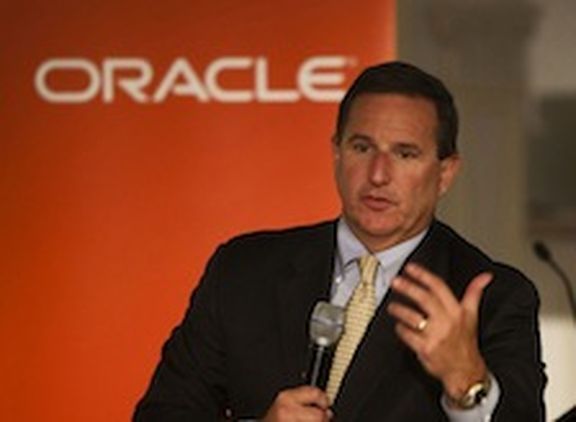
At Oracle CloudWorld today in New York, CEO Mark Hurd and several other executives are describing the company's partner and customer progress with cloud computing. Hurd has just taken the stage. Here's a minute by minute update.
First up: Here's a preview of the conference along with key partner and customer questions that Hurd will need to address during the show.
Hurd's key points:
1. IT spending: It has flattened out or it is down. The reason: Companies are making earnings by reducing expenses, he asserts. My thoughts: That's a bit of spin because Oracle is so dependent on traditional on-premises hardware and software sales, even as the company's cloud business continues to grow very quickly.
2. CEOs Are Under Pressure: While revenues aren't growing, the average CEO tour of duty is only 4.5 years. That means they don't have much time to fix or grow their businesses in a tough economy.
3. Shifting Workforce: 68 percent of millennials want a seamless customer experience. "They value a great customer experience more than my generation," says Hurd. Also, 50 percent of the workforce will be Millennials, he added.
4. How Service Providers Will Fail: He noted that big telecom companies do nothing to help you with your contract as you travel from one region to the next. Hurd puts up with the nonsense but Millennials won't. They'll move on to pro-active service providers, he adds.
5. Workforces Will Get Complex: As retirement ages rise, that means three generations of workers will need to coexist. "You'll need tools to accommodate" extreme work habits on every side of the table.
6. On-premises IT Operating Model Is Not Sustainable: The average on-premises enterprise application dates back to a 20 year legacy foundation. And 80 percent of a declining IT budget is spent on maintenance. Now throw in security and it's really tough to safeguard all that legacy infrastructure, he asserts.
7. Mark Hurd's Cloud Predictions:
- With SaaS, 80 percent of production apps will be in the cloud by 2025. Roughly 24 percent of the application market is SaaS today. 85 percent of new applications today are already architected for the cloud.
- Two suite providers will have 90 percent of the SaaS market by 2025. Oracle will be one of them, he predicted. Hurd declined to predict who the other giant player would be because he can't foresee how M&A will play out with other companies.
- Fixed infrastructure with fixed costs -- servers, etc. -- will shift 100 percent to the cloud by 2025. The big areas will be DevTest.
- By 2025 virtually all enterprise data will be stored in clouds.
- By 2025, enterprise clouds will be the most secure IT environments. And he asserted that Oracle is already there today.
Steve Miranda, Executive VP, Applications Development
Some paraphrased statements from Miranda:

- Oracle is designing 100 percent of its applications for 100 percent cloud adoption -- though the company will support on-premises application development for at least the next decade and likely beyond.
- Oracle eliminates all SaaS customizations and that allows for Oracle to do major release cycles every six months.
- Also, all data is encrypted and the customers hold the key.
Oracle Cloud Partner Strategy
ChannelE2E is attending the Oracle PartnerNetwork (OPN) breakout focused on partner opportunities in the cloud. Here are some anecdotes, which we've paraphrased:
- Partners comprise nearly 50 percent of Oracle's annual revenues.
- Oracle's big differentiators: Coverage across IaaS, PaaS and SaaS -- while also offering the same standard products on-premises and in the cloud, the company asserts.
- Partner program now includes "Cloud Registered" level -- an entry-level engagement approach for born in the cloud partners. There are no initial fees. Sounds like potential fees will start May 31,2016. It's a "low friction" way to get started, the company claims.
- Regardless of whether you're gold, platinum or another level -- get to know the cloud partner program components like... Referral, Co-Sell/Implementation and Resale.
- Referral (pays you 10 percent for a newly registered opportunity that's approved). The catch: You get one-third of the payment each year over the three-year deal. If it's a one-year deal you get it all that year. The cap is $50,000. Oracle Direct Sales manages the opportunity. There are no revenue commitments for the partner to be a referral company.
- Co-sell Implementation involves actually being involved in the implementation. There are levels here that generate more and more margin based on training and project levels. There was no mention of margin.
- Resale: Here, Oracle wants you to own the relationship. Oracle offers a rough 10 percent discount to the partners. (It can vary.) From there, the partner can negotiate any end-cost to the end-customer. Most successful partners will also bundle in their own services -- particularly managed services. When a value-added distributor is involved, Oracle bills the VAD. At time of provisioning, the partner has the customer sign an Oracle agreement to run in Oracle's data center. Oracle is offering an additional 10 percent discount for registered deals that flow through distributors. The partner must close the deal.
- Recurring Revenues: As customers re-up their existing contracts, partners that remain involved in that retention will continue to earn the Oracle recurring revenues.
- Cloud Sizing Calculator: Oracle has a sizing calculator but it's not available outside of the Oracle firewall. Ask your channel account manager to see if someone inside Oracle can leverage that tool to help you size a customer deployment.
- More to come. Stay tuned.
. Keep checking back: More updates coming every few minutes.




